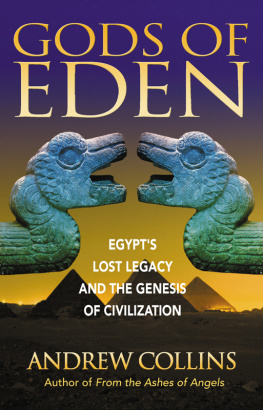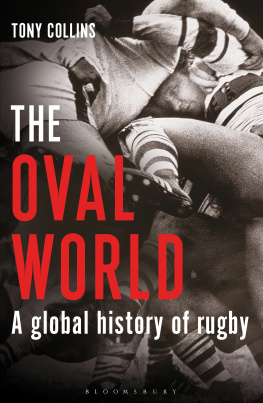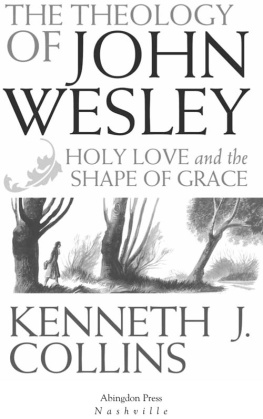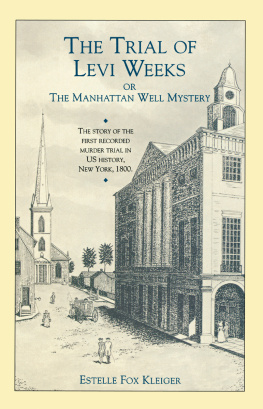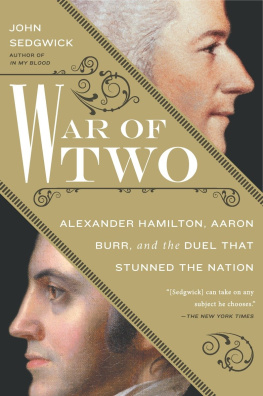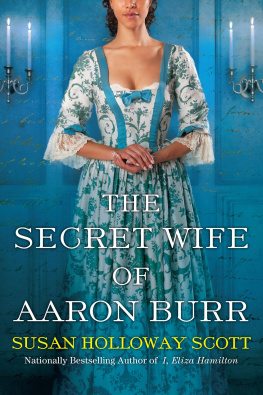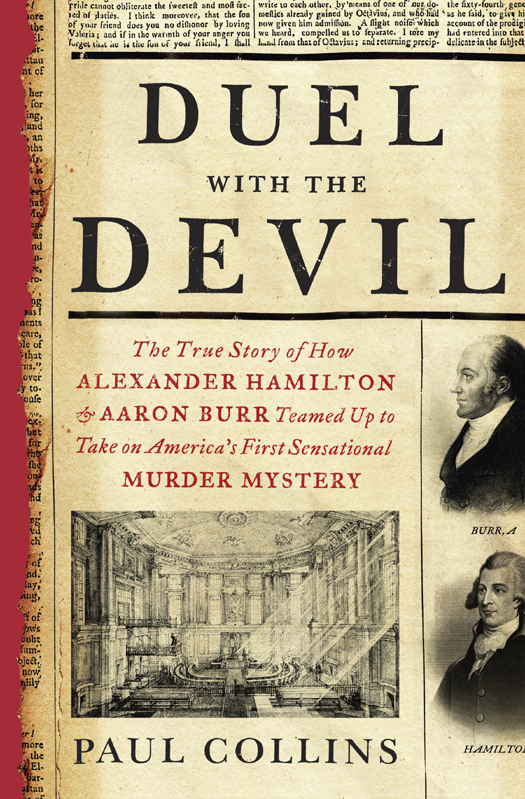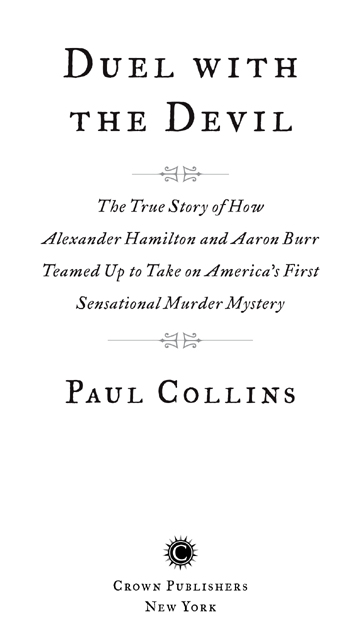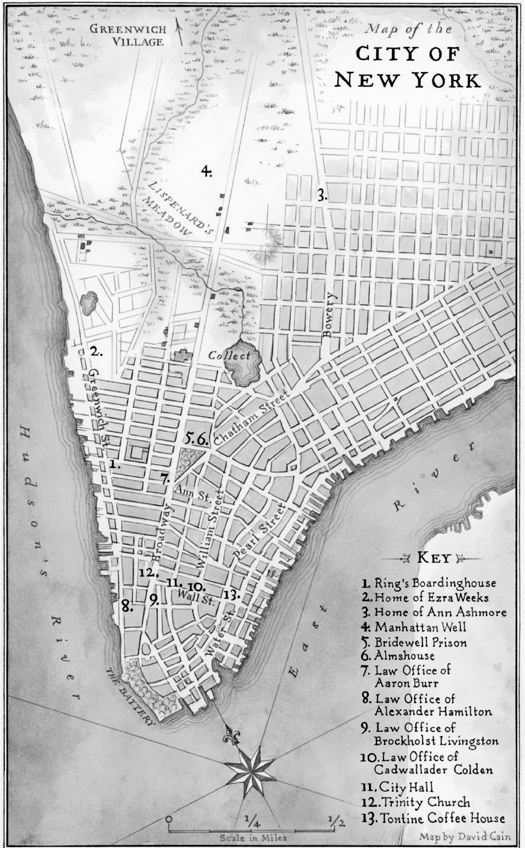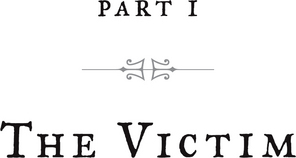A LSO BY P AUL C OLLINS
Banvards Folly:
Thirteen Tales of People Who Didnt Change the World
Sixpence House:
Lost in a Town of Books
Not Even Wrong:
A Fathers Journey into the Lost History of Autism
The Trouble with Tom:
The Strange Afterlife and Times of Thomas Paine
The Book of William:
How Shakespeares First Folio Conquered the World
The Murder of the Century:
The Gilded Age Crime That Scandalized a City and Sparked the Tabloid Wars
Copyright 2013 by Paul Collins
All rights reserved.
Published in the United States by Crown Publishers, an imprint of the Crown Publishing Group, a division of Random House, Inc., New York.
www.crownpublishing.com
CROWN and the Crown colophon are registered trademarks of Random House, Inc.
Cataloging-in-Publication data is on file with the Library of Congress.
eISBN: 978-0-307-95647-7
Map by David Cain
Jacket design by Albert Tang
Jacket illustrations: [House of Representatives] Encyclopaedia Britannica/
Universal Images Group/Getty Images; [Burr] MPI/Stringer Collection/Archive
Photos/Getty Images; [Hamilton] Kean Collection/Archive Photos/Getty Images
v3.1
To my brother Peter,
whose room was my first library
[C ONTENTS ]
PART I
THE VICTIM
PART II
THE ACCUSED
PART III
THE TRIAL
PART IV
THE VERDICT
D UEL WITH THE D EVIL
P ROLOGUE
[January 2, 1800]
A NDREW B LANCK HAD JUST BEEN SITTING DOWN TO LUNCH WITH a horsebreaker when Elias Ring and Joseph Watkins showed up and battered on his door. It was a bitterly cold day, and it took a fairly tough sort to live out in Lispenards Meadowbut the boardinghouse owner and his neighbor, an ironmonger, were not to be trifled with.
Where did you get it?
The well, Blanck replied. One of Aaron Burrs new municipal wells was out in the meadow, and Blancks son had found a muff, for covering the hands in cold weather, floating in there more than a week before. On Christmas Eve, in factjust as the bells were tolling for the death of General Washington.
I went to the well the next day and looked in, he explained, but I saw nothing.
Joseph and Elias marched out to the meadow, followed by the horsebreaker. The men threw off the wooden cover and ran a long pole down into the dark hole. Mr. Ring could feel an object in the water, a heavy and inert mass, but he couldnt hook it. The local boys were now gathering to look, and one was sent back for some rope, with which they created a simple net. This time the mass came up.
There was a tangle of hair floating in the watera wet shoulderand a face looking upwards
[Six Months Earlier]
I T WAS A FINE DAY FOR WONDERS . G IANT LOBSTER CLAWS, A LITTLE pagoda, some unburnable asbestos paperthese were the peculiar riches of a collection that the late Gardiner Baker had begun for his museum nearly a decade earlier, during General Washingtons triumphant first term in office. But in July 1799 the museum wilted in the drowsy Manhattan summer, its hush scarcely broken by the arrival of two young women in plain Quaker dress. Accompanying them was a strapping young man in the simple garb of a carpenter on his day off.
Elma?
The younger of the two women fell all too readily into morbid reverie, and sometimes her cousin Hope had to rouse her. But in a such a place as this, how could one not stop to gaze in wonder? Towering above them was Gilbert Stuarts grand oil portrait of Washingtonthe great man looked out over the museum, a reminder of when the country and the museum itself were both still new and wondrous. Back then, Manhattan was the infant countrys capital, and Bakers Museum was still housed down on Wall Street in a lovely sky-blue antechamber of the Stock Exchange. Customers paid two shillings to view an immense and intricate clock that waltzed through an entire concert, get shocked by one of Bakers splendid Electrical Machines, and stand in awe of a marvelous work of glass sculpturea TRANSPARENT MONUMENT , the ads promised. A figure of Christopher Columbus, it was lit to a fiery glow by a cunning arrangement of lanterns and chandeliers.
But now the glow was fading.
The sounds of commerce from Greenwich Street filtered into the new quarters that the old curators widow had been reduced to. Not so long ago, the museum had been wildly awake with Gardiners latest schemea menagerie of Living Animalsincluding everything from a pair of wolves and a bald eagle to a monkey and a Mongooz, a beautiful animal from the Island of Madagascar. Now they had lapsed into silence. Elmas cousin, Hope Sands, wandered past the nailed-shut storage boxesfilled, perhaps, with old Mr. Bakers hundreds of volumes of philosophy and natural historyand their fellow boarder Levi Weeks could pause before the wax figures of the great boxers Mendoza and Humphries, still posed as if ready to clobber each other. Nearby, a figure of Ben Franklin gazed impotently among waxworks of once-titillating feminine beauties of New York, Annapolis, Salem, and New Haven.
The famed Musical Concert Clock is for sale, visitors were mournfully informed. That is, should you wish to buy it.
They did not: They were ready to leave. It was a shame, the passing of the old curatorbut that summer in New York, deaths were no surprise at all.
S IGNS HUNG along the streets, creaking slightly whenever the breeze stirred, each proclaiming where its shopkeeper had come from:
S TEPHEN D ANDO ,
FROM L ONDON ,
H ATTER .
L AW A ND B UTTE ,
FROM G LASGOW ,
B OOT M AKERS .
A NTOINE A RNEUX ,
A LA P ARIS ,
M ARCHAND T AILLEUR .
It was a tradition peculiar to Manhattan. Shopkeepers mentioned their hometowns in the hope of landing customers from their newly arrived countrymen; for everyone here, it seemed, hailed from somewhere else. Manhattan was where you went to reinvent yourself, whether you were slightly fractured nobility from Paris, a rabble-rousing radical from Londonor, like Elma and Hope, young Quaker women from an upstate farm, simply looking to find better prospects in life.
The city swelled with such arrivals, and its population of sixty thousand made it the largest city in the young republic. Greenwich Street, once a rustic lane running through riverside meadows, was now sprouting fashionable brick houses and storefronts at a stunning rate. After a visit to widow Bakers museum, you could stop into William Maxwells, Distiller & Tallow Chandler, for a good dose of his vaunted rum, and thus fortified, go to the next shop over for some godless tract such as Palmers


